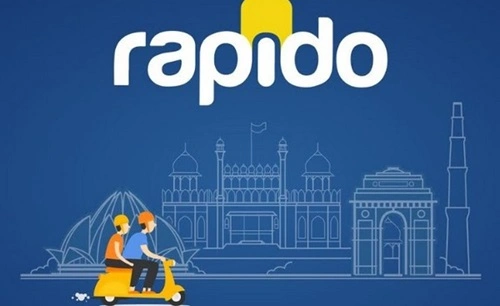Rapido, India’s first and largest bike taxi aggregator, has revolutionized urban transportation by offering affordable, fast, and convenient commuting options. Founded in 2015 by Aravind Sanka, Pavan Guntupalli, and Rishikesh SR, Rapido aims to address traffic congestion, high travel costs, and inefficiencies in last-mile connectivity. With over 50 million app downloads and operations in more than 100 cities, Rapido has established itself as a leading player in the on-demand transportation industry.
In this article, we’ll explore Rapido’s business model, revenue streams, and strategies that have enabled its success in a competitive transportation market.
Overview of Rapido’s Business Model

Rapido operates as a shared economy-based platform, connecting bike owners (captains) with commuters looking for cost-effective and quick rides. Its model is similar to other ride-hailing platforms like Uber and Ola but focuses on two-wheelers, making it distinct and more affordable.
Key Features of Rapido’s Business Model:
- Bike Taxi Services: Rapido offers bike taxis for urban commuters, allowing them to book a ride through its mobile app.
- Hyperlocal Operations: The platform primarily caters to short-distance travel, ensuring fast and efficient service in congested cities.
- Gig Economy: Rapido operates on a gig economy model, where bike captains are independent contractors rather than full-time employees.
- Tech-Driven Platform: Rapido leverages technology for ride-matching, route optimization, and real-time tracking, providing a seamless experience for users and captains.
How Rapido Earns Money
Rapido’s revenue model is built around multiple streams, leveraging its core bike taxi service while diversifying into additional offerings. Here’s how Rapido earns money:
a. Commission on Rides
- Rapido takes a percentage commission (typically around 15-20%) from the fare paid by customers for every completed ride.
- Captains earn the remaining portion of the fare, which incentivizes them to participate actively on the platform.
b. Ride Fares
- Customers pay a fare based on factors like distance, ride duration, and surge pricing during peak hours.
- The affordability of bike taxis compared to traditional ride-hailing services ensures steady demand and revenue.
c. Subscription Plans
- Rapido offers subscription-based plans that provide benefits like discounted rides, reduced surge pricing, and priority bookings. These plans generate recurring revenue while fostering customer loyalty.
d. In-App Advertising
- Rapido monetizes its platform by offering in-app advertising opportunities to businesses and brands. These ads are targeted at a highly engaged user base, ensuring better ROI for advertisers.
- Sponsored placements, banner ads, and partner promotions contribute to this revenue stream.
e. Rapido Delivery Services
- Rapido has diversified into last-mile delivery services, catering to businesses and individuals who need fast and reliable parcel deliveries.
- It earns revenue through delivery fees charged to customers, with captains acting as delivery partners.
f. Corporate Partnerships
- Rapido collaborates with businesses to provide customized transportation solutions for employees, such as corporate ride packages and shuttle services.
- These partnerships generate bulk revenue and strengthen Rapido’s presence in the B2B segment.
g. White-Label Solutions
- Rapido offers its technology infrastructure as a white-label solution to other transportation businesses, enabling them to manage their operations efficiently.
- Revenue is earned through licensing fees or revenue-sharing agreements.
h. Surge Pricing
- During peak hours or high-demand periods, Rapido implements surge pricing, where fares increase based on demand-supply dynamics. The additional revenue from surge pricing boosts profitability during critical hours.
Why Rapido’s Model Works
Rapido’s business model succeeds due to its focus on affordability, efficiency, and convenience. Here are the factors that make it work:
a. Affordable Transportation
- Two-wheelers are cheaper to operate and maintain compared to cars, allowing Rapido to offer rides at much lower rates.
- This affordability appeals to price-sensitive urban commuters, especially in Tier 2 and Tier 3 cities.
b. Fast and Efficient Rides
- Bike taxis can navigate through heavy traffic and congested urban areas more efficiently than cars, making them an ideal choice for short-distance travel.
c. Focus on Last-Mile Connectivity
- Rapido addresses last-mile connectivity challenges by providing a convenient solution for commuters traveling to or from public transport hubs.
d. Tech-Driven Operations
- The use of advanced algorithms for route optimization, ride matching, and real-time tracking enhances user experience and operational efficiency.
e. Large Gig Workforce
- Rapido’s gig economy model attracts a large pool of bike captains who value the flexibility and additional income opportunities the platform offers.
Financial Performance
Rapido has seen significant growth since its inception. Key financial highlights include:
- Revenue Growth: Rapido’s annual revenue has grown consistently, driven by increasing ride volumes and diversified service offerings.
- User Base Expansion: With over 50 million app downloads, Rapido has a strong and growing user base, contributing to its financial success.
- Funding: The platform has raised significant funding from investors like WestBridge Capital, Nexus Venture Partners, and Shell Ventures, with a valuation exceeding $800 million as of 2024.
Challenges and Opportunities
Challenges
- Regulatory Hurdles:
- Bike taxi services face regulatory challenges in several Indian states due to unclear or restrictive transportation laws.
- Competition:
- Rapido competes with giants like Ola and Uber, which have launched bike taxi services, as well as local players.
- Profitability:
- Maintaining profitability is challenging due to high operational costs, discounts, and incentives for captains.
Opportunities
- Geographic Expansion:
- Rapido has significant growth potential in Tier 2 and Tier 3 cities, where public transportation options are limited.
- B2B Market:
- Expanding corporate partnerships and delivery services can unlock new revenue streams.
- Technology Integration:
- Investments in AI and data analytics can further optimize routes, improve efficiency, and enhance the user experience.
- Electric Vehicles (EVs):
- Incorporating EVs into its fleet can reduce operational costs and align with sustainability goals.
Future Prospects
Rapido’s focus on innovation and addressing urban mobility challenges positions it well for future growth. Key areas of focus include:
- Expanding last-mile delivery services to cater to the booming e-commerce and logistics markets.
- Partnering with governments and local authorities to streamline regulatory compliance and expand operations.
- Promoting electric bike adoption to enhance profitability and environmental sustainability.
- Strengthening its subscription-based offerings to boost customer retention and recurring revenue.
Conclusion
Rapido’s business model is a testament to how technology and innovation can transform urban transportation. By focusing on affordability, convenience, and efficiency, Rapido has successfully carved a niche in the competitive ride-hailing market. With diversified revenue streams, a growing user base, and strategic expansion plans, Rapido is well-positioned to sustain its growth and become a leader in India’s urban mobility landscape. As it continues to overcome challenges and seize new opportunities, Rapido is poised to remain a key player in the future of transportation.

